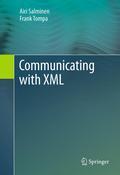
This book provides extensive insight into the possibilities and challenges ofXML in building new information management solutions in networked organizations. After a brief introduction to Web communication features and XML fundamentals, the book examines the benefits of adopting XML and illustrates various types of XML use: XML in document management; XML for data-centric and multimedia components; XML as a format for metadata, including metadata for the Semantic Web; and XML in support of data interchange between software applications and among organizations. The challenges of adopting XML in large-scale information management are also discussed. In addition, applications across a broad spectrum are examined and numerous case studies pertaining to the adoption of XMLare presented. The book is particularly suitable for courses offered in Information Studies, Information Systems, or Information Technology. It also servesas an excellent practical guide for professionals in information management and provides important support material for courses in Computer Science and in Business. Introduces XML technologies using an information-centric focus. Shows why and how XML has become ubiquitous on the Web. Presents major members of W3C's XML family of languages without expecting readers to be proficient programmers. INDICE: Setting the Stage. Fundamentals. Why use XML?. Document Management. Data-Centric and Multimedia Components. Metadata. Data Interchange. AdoptingXML for Large-Scale Information. Introduction to XHTML. History of XML. Extended Backus-Naur Form (EBNF)
- ISBN: 978-1-4614-0991-5
- Editorial: Springer US
- Encuadernacion: Cartoné
- Páginas: 248
- Fecha Publicación: 28/10/2011
- Nº Volúmenes: 1
- Idioma: Inglés
